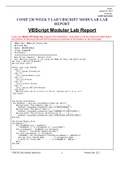Solving
Data structures and programming are foundational elements in computer science and play a
crucial role in developing efficient software solutions. At the core, programming involves writing
code to instruct a computer on performing specific tasks, while data structures are ways of
organizing and storing data for efficient access and modification. Understanding these two
concepts is essential for solving real-world problems across various fields, from business and
medicine to artificial intelligence.
Data structures include arrays, linked lists, stacks, queues, trees, and graphs, each with unique
attributes that make them suitable for different applications. For instance, arrays are simple data
structures used to store a fixed number of elements in a sequential manner, ideal for cases where
the number of elements is known in advance. Linked lists, on the other hand, allow dynamic
memory allocation and are helpful when the number of elements may change frequently. More
complex structures, like trees and graphs, are used in applications such as organizing file systems
and social networks, respectively. For example, a binary search tree allows efficient searching,
insertion, and deletion of data, which is beneficial in database indexing.
Programming languages like Python, Java, and C++ offer built-in data structures and tools to
implement these concepts. In Python, a simple list can be used as an array, while libraries like
collections provide more advanced data types like deque for stacks and queues. Through
programming, these structures can be applied in solving real-world problems, such as using a
queue in a customer support system to handle requests in the order they are received.
By learning how to effectively use data structures and programming concepts, students gain the
skills necessary to create optimized, scalable solutions, preparing them for advanced topics like
algorithm design and machine learning.










